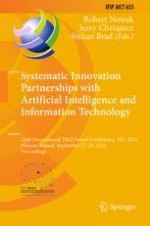2022 | Buch
Systematic Innovation Partnerships with Artificial Intelligence and Information Technology
22nd International TRIZ Future Conference, TFC 2022, Warsaw, Poland, September 27–29, 2022, Proceedings
herausgegeben von: Robert Nowak, Jerzy Chrząszcz, Stelian Brad
Verlag: Springer International Publishing
Buchreihe : IFIP Advances in Information and Communication Technology
